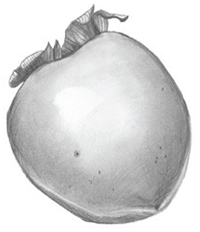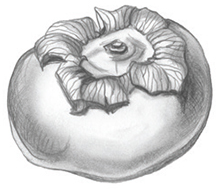 As a little girl, I was fascinated by the beguiling, orange tomato-like fruits that hung temptingly from the tree by my grandma’s porch. If you bit in before the fruit was ripe, the sharp, astringent taste would result in a “persimmon pucker” grimace. But, when soft and almost mushy, the fruit was deliciously sweet and almost irresistible.
As a little girl, I was fascinated by the beguiling, orange tomato-like fruits that hung temptingly from the tree by my grandma’s porch. If you bit in before the fruit was ripe, the sharp, astringent taste would result in a “persimmon pucker” grimace. But, when soft and almost mushy, the fruit was deliciously sweet and almost irresistible.
All persimmons (from the genus Diospyros, which loosely means “fruit of the gods”) are native to Japan and were brought to America by early colonists. They are among the most underused fall and winter fruits, probably because many people are not familiar with them. Their honey-sweet taste definitely deserves our consideration, however, when planning tradition-enhancing recipes.
The two most familiar types of persimmons are Fuyu and Hachiya. The Fuyu persimmon is round and squat. When the tough skin is peeled and the firm fruit sliced, its sweet flavor can be savored as-is or used to liven up autumn salads.
Long and acorn-like, Hachiya persimmons are excellent for use in baking sweet cakes, cookies, breads or puddings. When shopping for Hachiya, choose those with flesh similar to jelly with a juicy feel. You can purchase them slightly underripe, but take them home and allow the fruit to ripen at room temperature before baking with them.
Keep reading for ways to use this brilliant orange “fruit of the gods” as a pleasant and unexpected addition to festive fall menus.
 Hachiya Persimmon
Hachiya Persimmon
Round with a pointed tip, the Hachiya is astringent and should only be eaten when ripe or you will forever regret it. When the flesh is like an overripe tomato, it’s ready to use in baking recipes, smoothies or ice cream.
 Fuyu Persimmon
Fuyu Persimmon
The squat Fuyu is non-astringent and perfect to eat raw like an apple. Slice it and serve with cheese and honey or dice into a salad with seasonal greens and pecans. Remove the tough peel before consuming.
Persimmon Particulars
- Persimmons can be eaten fresh, dried or cooked into pies, cookies, breads or cakes.
- Native Americans relished the ripened, sweet fruit, which they mashed with corn into a gruel. They used the unripened fruit medicinally to stop bleeding and as a gargle to soothe sore throats.
- In the autumn, when the leaves on the persimmon tree begin to fall and the fruit develops a cracked appearance, it is time to pick.
- Persimmons are quite nutritious. They contain vitamins A and C, glucose, protein, potassium, iron and manganese. They are low in calories, cholesterol, and sodium and are full of dietary fiber.
Ways To Enjoy Persimmons
1. Pureed Hachiya persimmons can be frozen and sprinkled over vanilla ice cream as a tasty topping.
2. Hachiya persimmon pulp can be substituted for banana or pumpkin when making quick holiday breads.
3. To make appealing appetizers, thinly slice ripe Fuyu persimmons, place your favorite cheese on crackers and top with the sliced persimmons. Broil until the cheese melts and serve to oohs and aahs.
4. Sliced Fuyu persimmons can be tossed together with sliced beets, mandarin slices and butter greens to create a festive holiday salad.
5. Ripe Fuyu persimmons are a fantastic and simple dessert when halved, drizzled with honey and broiled until caramelized.





